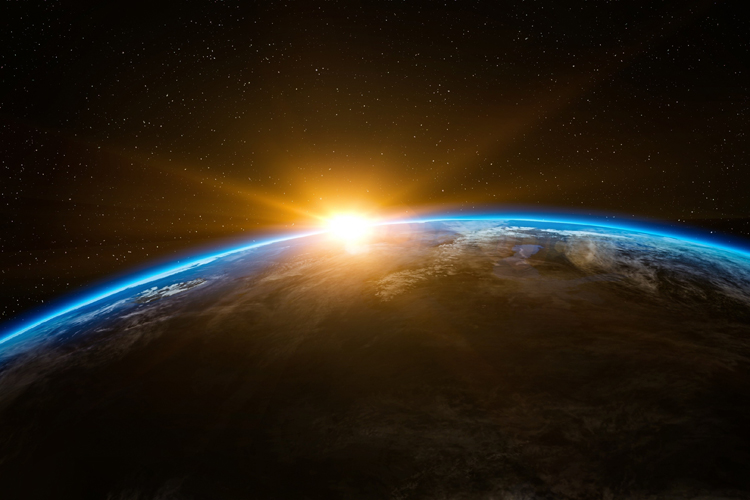The Sun plays a critical role on Planet Earth. Discover 50 surprising facts about the star that gives life to the Solar System.
From our perspective, the Sun rises in the east and sets in the west. The "big ball of fire" - or gas, to be more precise - is also our nearest star.
It is the most important source of energy for life on Earth. Without it, we wouldn't be here.
Contrary to popular belief, the Sun will never explode. Instead, it will eventually morph from a "red giant" into a "white dwarf."
Take a look at the most interesting facts about the sun. Here's everything you might not know about the star of the Solar System:
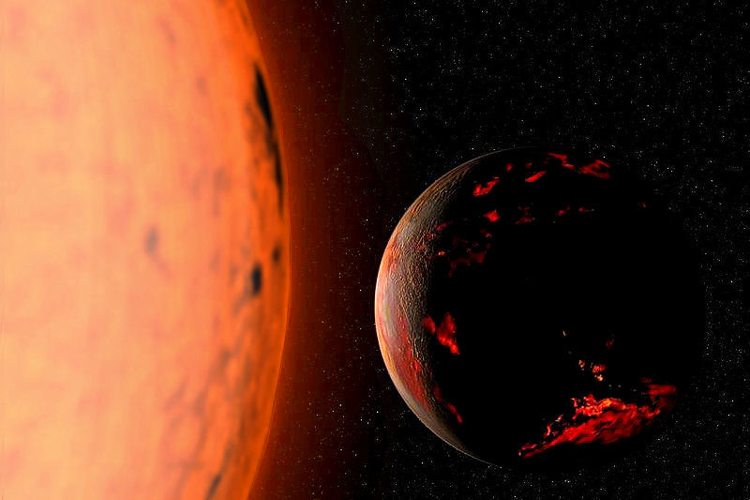
1. How old is the Sun? Most scientists believe that the Sun is about the same age as Earth and all the other seven planets of the Solar System, i.e., 4.5 billion years;
2. How was the Sun born? It is the result of the collapse of part of a giant molecular cloud that consisted mostly of hydrogen and helium, and that possibly gave birth to many other stars;
3. What type of star is the Sun? The official scientific classification is G2V;
4. What is the Sun made of? The ball of fire consists of 74.9 percent hydrogen, 23.8 percent helium, and 2 percent heavier elements such as carbon, nitrogen, oxygen, iron, and neon;
5. Hydrogen is Sun's primary fuel;
6. How does the Sun burn if there is no oxygen in space? The truth is that it doesn't actually "burn." It converts burned hydrogen into helium by using carbon, nitrogen, and oxygen as catalysts;
7. At the Sun's core, temperatures reach at least 27,000,000 °F (15,000,000 °C);
8. The surface of the Sun has an average temperature of 9,941 °F (5,505 °C or 5,778 K);
9. Can humans land on the Sun? Technically, it is still not possible. However, Parker Solar Probe, a NASA robotic spacecraft launched in 2018, will approach within 4.3 million miles (6.9 million kilometers);
10. What is inside the Sun? The star of the Solar System features six different layers: the core, the radiative zone, the convective zone (inner layers), the photosphere, the chromosphere, and the corona (outer layers);
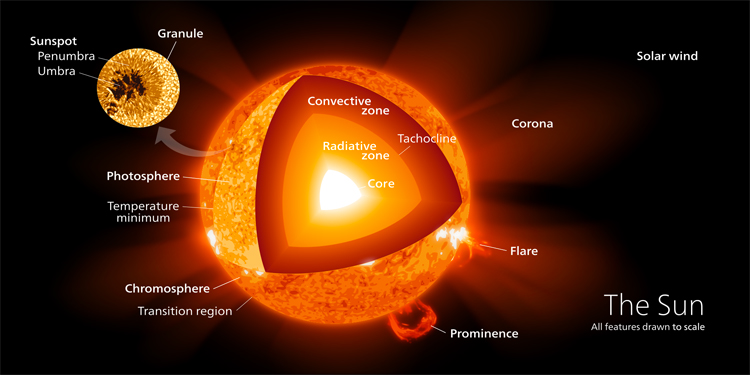
11. The Sun is at the center and heart of the Solar System thanks to its powerful gravitational pull and an extensive magnetic field;
12. The Sun releases an enormous amount of energy by nuclear fusion in the form of radiation, electricity, and solar wind. On Earth, we get the chance to receive its heat and light;
13. How far is the Sun from the Earth? Its mean distance from the Earth is equivalent to 8 minutes and 19 seconds at the speed of light. In other words, they're 92,955,807 miles (149,597,870 kilometers) apart;
14. The Sun's volatility is contained thanks to its tremendous gravity, which keeps the eight planets of the Solar System held together;
15. It's strong enough to hold the solar system intact, primarily due to the Sun's size and mass;
16. The Sun is the largest and most massive object in the solar system. It contains approximately 99.86 percent of all the mass in the solar system;
17. It's more than 100 Earths wide and could theoretically fit all eight planets inside nearly 600 times, or 1.3 million Earths;
18. The Sun's magnetic field - called the heliosphere - protects the planets from harmful cosmic radiation;
19. Although invisible to the naked eye, the Sun's surface features a few dark areas - sunspots. These strong pockets of magnetism interact with the Earth's atmosphere, creating the so-called Aurora Borealis;
20. Scientists believe that the Sun's changes in its magnetic field influence and have an impact on the surface pressure of the Earth's atmosphere, resulting in changes in weather patterns;
21. Solar flares are the most violent manifestations of the Sun at the peak of its solar cycle;
22. The American, French, and Russian revolutions and the Paris Commune occurred during solar maximum, the 11-year cycle of highest Sun activity;
23. The magnetic fields created by the Sun can be strong enough to disrupt communications on Earth;
24. The diameter of the Sun is 856,658 miles (137,8657 kilometers) larger than that of the Earth;
25. The Earth is one of the Sun's many satellites, alongside 750,000 asteroids;
26. Earth orbits the Sun at an average distance of 92,955,807 miles (149,597,870 kilometers);
27. However, depending on the time of the year (January or July), it can be at 91 million miles (146 million kilometers) or 94.5 million miles (152 million kilometers);
28. Until the 16th century, it was thought that the Sun orbited the Earth;
29. How bright is the Sun? It is 400,000 times brighter than a full Moon and brighter than 85 percent of the stars in the Milky Way;
30. The Sun is responsible for 45 percent of the tidal forces generated on Earth - the Moon does the rest;
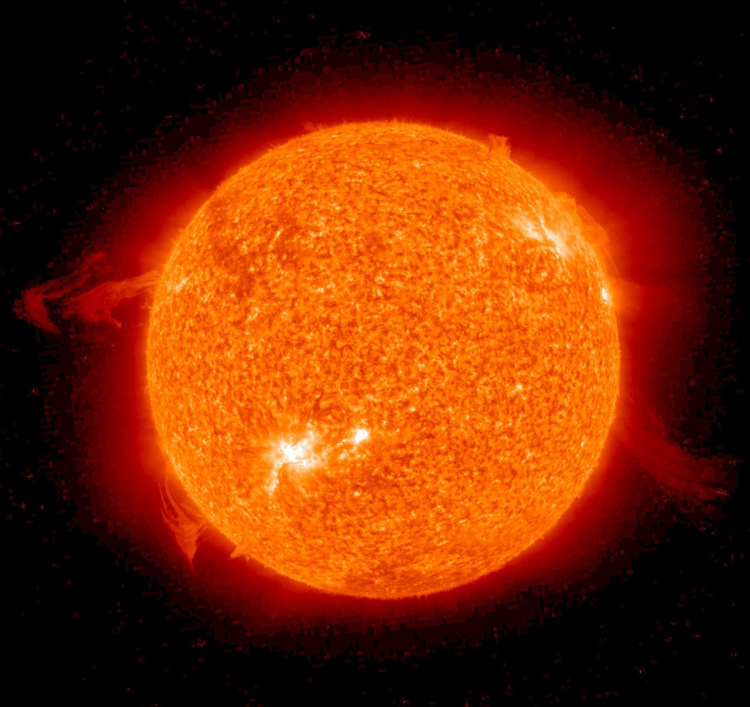
31. When the Sun and Moon are pulling in the same direction, they're stretching the Earth, thus making humans microscopically taller;
32. Every second, the Sun provides the energy equivalent to 10 billion nuclear bombs;
33. The solar wind is a celestial breeze made of electrons and protons that have escaped from the Sun's gravity. It travels at 280 miles per second (450.6 kilometers per second) and takes up to four days to reach the Earth;
34. The light emitted by the Sun takes 8 minutes and 19 seconds to reach the Earth. However, that same ray of light is estimated to be between 50 and 100,000 million years old by the time it "touches" our skin;
35. The Sun rotates in the opposite direction to Earth and travels at 220 kilometers per second;
36. The Sun is the closest thing to a perfect sphere found in nature. Despite its size, there is only a 10-kilometer difference in its equatorial and polar diameters;
37. How long would the Earth survive without the Sun? Not much. The absence of sunlight would lower the Earth's temperature to about -148 °F (-100 °C) in a month;
38. What is the exact color of the Sun? The Sun is not orange, yellow, or red. In reality, it is white;
39. Who named Sun? The word "Sun" has its origins in the Old English spelling "Sunne";
40. In Ancient Greece, the big, glowing star was known as Helios. In Ancient Rome, the flaming orb was called Sol. In Ancient Egypt, the star was named Ra;
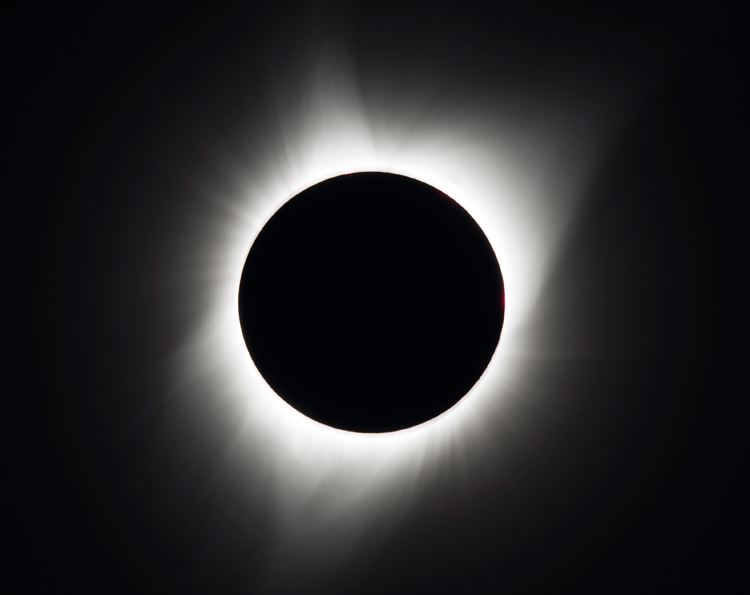
41. Stonehenge, built somewhere between 3,000 BC and 2,000 BC, is aligned so that on the solstice, the Sun rises directly over the heel stone, and the first rays shine into the center of the stone circle;
42. Greek astronomer and mathematician Aristarchus of Samos was the first person to suggest that the Sun is the center around which planets orbit. The theory was presented between 310 BC and 230 BC;
43. Aristarchus' heliocentric vision was later developed in detail by Nicolaus Copernicus in the 16th century;
44. A person weighing 165 pounds (75 kilograms) on planet Earth would weigh 4,466 pounds (2,025 kilograms) on the Sun's surface;
45. Between 18 and 35 percent of the world's population sneeze when exposed to sunlight - it's the photic sneeze reflex, also known as Autosomal Compelling Helio-Ophthalmic Outburst (ACHOO);
46. On December 10, 2019, the Daniel K. Inouye Solar Telescope took the highest-resolution photo of the Sun of all time. The picture reveals the surface of the star of the Solar System divided up into small popcorn-line cells and plasma rising high into the solar atmosphere. The optical instrument is located in Maui, Hawaii;
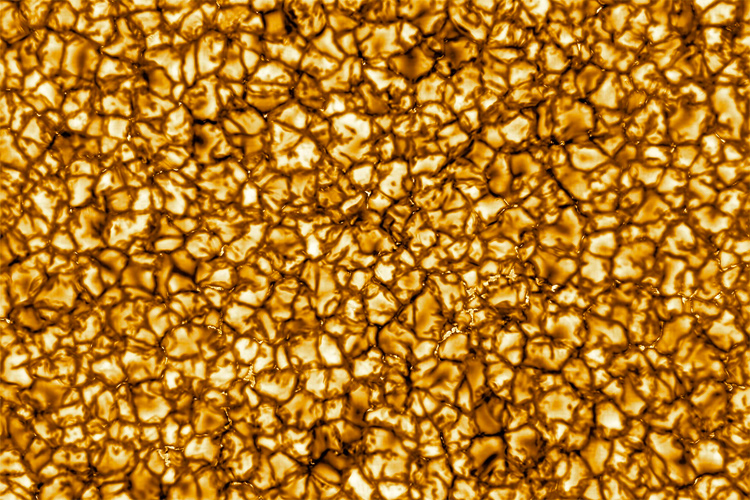
47. Indian astrologists have 12 different names and meanings for the Sun, representing the 12 months of the year: Mitra (The Friend), Ravi (The Radiant), Surya (Giver of Beauty), Bhanu (Catalyst of Emotion), Khaga (Awesome), Pushna (Nourisher), Hiranya Garba (The All-Inclusive), Marica (Destroyer of Darkness), Aditya (Illuminator of the Way), Savitra (The Arouser), Arka (Flash of Warmth) and Bhaskara (Liberator);
48. During a total solar eclipse, the human eyes can see the solar corona for a brief period;
49. The Sun's ultraviolet light has antiseptic properties and can be used to sanitize water and tools;
50. How long will the Sun last? In between 5 and 6.5 billion years, the Sun will run out of hydrogen, turn red, and expand to engulf Mercury, Venus, and Earth and then collapse into a small star known as a white dwarf;
51. When will the Sun make life on Earth impossible? It is possible that in about 1.5 billion years, the Earth will become uninhabitable - average temperatures of 176 °F (80 °C) will make it too hot, and oceans will evaporate;
